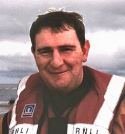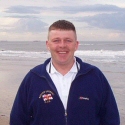|  Helmsman
Mark Reeves was awarded the Walter and Elizabeth Groombridge
award after the Redcar Atlantic 75 lifeboat was judged to have performed
the most meritorious service by this class of lifeboat in 2003. The rescue
has already earned Mark one of the RNLI’s highest awards -
the Thanks of the Institution on Vellum. Helmsman
Mark Reeves was awarded the Walter and Elizabeth Groombridge
award after the Redcar Atlantic 75 lifeboat was judged to have performed
the most meritorious service by this class of lifeboat in 2003. The rescue
has already earned Mark one of the RNLI’s highest awards -
the Thanks of the Institution on Vellum.
The rescue on 15 August 2003 involved both Redcar lifeboats, the Atlantic
75 and the D class. Crewmen Jon Danks and Thommy
McNamara were with Mark in the Atlantic and
while he used considerable skill to manoeuvre the boat in heavy seas,
they were able to pull the casualty aboard.
The RNLI’s Training Divisional Inspector for the North, Robin Warrington,
said at the time: ‘This award is thoroughly deserved. Mark
is an experienced helmsman and this is the first time in his fifteen years
with the RNLI where he can genuinely say he has saved a life by being
there in the nick of time.'
At 2.42pm on 15 August 2003 Humber Coastguard requested the launch of
both RNLI inshore lifeboats to assist a lifeguard and a surfer who were
in difficulties at Saltburn, 3.5 miles to the southeast of the lifeboat
station. The lifeboat operations manager at Redcar, Ian Readman,
activated the crew pagers at 2.44pm.
The crew assembled and at 2.50pm the Redcar Atlantic 75 lifeboat Leicester
Challenge II launched from the beach. The weather at the launch site was
wind easterly force 4, slight to moderate sea with a one metre swell,
good visibility and cloudy skies.
 The
lifeboat, with Helmsman Mark Reeves in command, and Crewmen
Jon Danks and Thommy McNamara aboard
made best speed for Saltburn. Once clear of the protection that lies immediately
off Redcar beach it was apparent that there was a heavy three to four
metre swell running from the north. Mark set his course
slightly further offshore than normal to avoid the steepening swell in
the shallower waters. Jonathan Danks established radio
contact with Humber Coastguard who confirmed that there were up to three
people missing in the water. The
lifeboat, with Helmsman Mark Reeves in command, and Crewmen
Jon Danks and Thommy McNamara aboard
made best speed for Saltburn. Once clear of the protection that lies immediately
off Redcar beach it was apparent that there was a heavy three to four
metre swell running from the north. Mark set his course
slightly further offshore than normal to avoid the steepening swell in
the shallower waters. Jonathan Danks established radio
contact with Humber Coastguard who confirmed that there were up to three
people missing in the water.
At 2.54pm the Redcar D class lifeboat Peterborough Beer Festival I launched
from the beach. Weather conditions were as for the Atlantic launch. Helmsman
Mark Greaves was in command and Crew Member David Bourne
was aboard. Mark Greaves made best speed for Saltburn
in support of the Atlantic, again the lifeboat coped well with sea conditions.
At 2.59pm the Atlantic lifeboat arrived at the scene. The beach profile
of Saltburn Sands is a very shallow gradient such that the swells were
breaking heavily from two to three hundred metres offshore, making the
area popular with surfers. The size of the swell approaching the search
area was such that the view of the beach was very difficult to pick up
unless the lifeboat ran in on the crest of a wave. Helmsman MarkReeves
briefed his crew before entering the rough water, his intention being
to run in through the surf towards the beach, and his crew were given
instructions to search between the waves on the run in. Mark
would turn the lifeboat out to sea when he became concerned about the
depth of water available.
Mark was aware that the flood tide coupled with the
shore rip would set the lifeboat towards the pier at Saltburn, he was
worried that the casualty had been swept under the pier where they would
be unable to help. He chose his wave and ran into the heavy surf, which
was breaking in excess of three metres. The waves were between one and
three boat lengths apart, and about 200 metres of white water was running
into the shallows.
Jon Danks spotted something yellow off to the port side
at about 30 metres distance and it became apparent this was the lifeguard
wearing his yellow tee shirt. Mark turned the lifeboat
towards the casualty, and, balancing the need for power against the surf,
effectively ‘glided’ the lifeboat towards the casualty. The
minimum depth of water noted was one metre. It could be seen that the
casualty was being thrown around violently by the spilling surf, and was
spending considerably more time under the water than above it. Jon
and Tommy discussed the option of entering the water
should it become necessary, and Tommy volunteered. The
lifeboat took on about six broken waves before being close enough to the
casualty to effect a rescue. The casualty was visible to Mark
about 50% of the time between breaking seas.
Mark brought the casualty alongside on the starboard
side, astern of the throttle controls. Tommy managed
to grab the casualty’s hand, then Jon got the other
hand and pulled him quickly aboard. The casualty was put on to the bench
seat and Jon and Tommy concentrated
on keeping him in the boat. The lifeguard confirmed that there were no
other people in the water, the other two having made the shore.
There was constant broken water washing through the lifeboat at this
stage as Mark took the lifeboat slowly seaward through
the worst of the breaking water. The lifeboat was being stood vertical
at times, and he had to work skilfully to balance power against speed.
The distance between the sets of breakers was such that he was unable
to pick his route through the surf, and had to take on whatever was in
front of him. After taking on four to six waves the lifeboat cleared the
surf and was back in the relative calm of the clean swell.
The casualty was responsive but very cold and shivering and remarked
that he could not have lasted much longer. He was placed in a survival
bag and fitted with a lifejacket. The D class then arrived on scene, the
time was 3.08pm, and it was confirmed to the shore that there were no
other people in the water. There was an ambulance waiting on the beach
and after discussion it was decided to transfer the casualty, with Jon,
to the D class to be landed on the beach.
The D class lifeboat ran into the beach with four people aboard, and
experienced an uncomfortable but safe passage into the beach. The extra
weight of the third crew would be needed to leave the beach safely. Once
clear of the more powerful surf the lifeboat was manoeuvred some distance
to the shoreline where the casualty was handed over to the waiting coastguard
and ambulance personnel at 3.14pm.
 The
D class then picked its way though the surf, experiencing little difficulty
until the last six waves when, as with the Atlantic, Helmsman Mark
Greaves had to balance power against speed. The breaking surf
needed a moderate amount of power to break through, and all three aboard
the D class landed heavily several times. The
D class then picked its way though the surf, experiencing little difficulty
until the last six waves when, as with the Atlantic, Helmsman Mark
Greaves had to balance power against speed. The breaking surf
needed a moderate amount of power to break through, and all three aboard
the D class landed heavily several times.
At 3.20pm both boats proceeded back to station, arriving at the beach
at 3.28pm and being ready for service by 4.15pm.
|

